| Listing 1 - 6 of 6 |
Sort by
|

ISBN: 9812380620 9810225628 9789812380623 9789810225629 Year: 1998 Publisher: Singapore: World scientific,
Abstract | Keywords | Export | Availability | Bookmark
 Loading...
Loading...Choose an application
- Reference Manager
- EndNote
- RefWorks (Direct export to RefWorks)
Nanoscience --- Friction --- Nanostructured materials --- Surfaces (Physics) --- Polymers --- Ultrasonic waves --- reologie --- Classical mechanics. Field theory
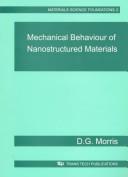
ISBN: 0878497978 Year: 1998 Publisher: Zürich : Trans Tech publications,
Abstract | Keywords | Export | Availability | Bookmark
 Loading...
Loading...Choose an application
- Reference Manager
- EndNote
- RefWorks (Direct export to RefWorks)
Nanostructured materials --- -Nanomaterials --- Nanometer materials --- Nanophase materials --- Nanostructure controlled materials --- Nanostructure materials --- Ultra-fine microstructure materials --- Microstructure --- Nanotechnology --- Testing --- Testing. --- -Testing --- Nanomaterials --- NANOSTRUCTURES --- MECHANICAL PROPERTIES --- ALLOYS --- PROPERTIES
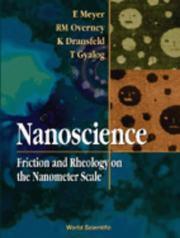
ISBN: 9812385339 9789812385338 9789810225629 9810225628 9812380620 9789812380623 9812380620 Year: 1998 Publisher: Singapore New Jersey World Scientific
Abstract | Keywords | Export | Availability | Bookmark
 Loading...
Loading...Choose an application
- Reference Manager
- EndNote
- RefWorks (Direct export to RefWorks)
Friction force microscopy is an important analytical tool in the field of tribology on the nanometer-scale. The contact area between the probing tip and the sample is reduced to some square nanometers, corresponding to the ideal of a single asperity contact. Traditional concepts, such as friction coefficients, adhesion and elasticity and stick-slip are re-examined with this novel technique. New concepts based upon classical and quantum mechanics are investigated.Contents: Introduction and Motivation; Instruments; Normal Forces at the Atomic Scale; Understanding of Lateral Forces; Dissipatio
Friction. --- Nanostructured materials. --- Surfaces (Physics) --- Rheology. --- Polymers. --- Ultrasonic waves. --- Nanomaterials --- Nanometer materials --- Nanophase materials --- Nanostructure controlled materials --- Nanostructure materials --- Ultra-fine microstructure materials --- Microstructure --- Nanotechnology --- Mechanics --- Bearings (Machinery) --- Tribology --- Supersonic waves --- Waves, Ultrasonic --- Sound-waves --- Ultrasonics --- Polymere --- Polymeride --- Polymers and polymerization --- Macromolecules --- Colloids --- Deformations (Mechanics) --- Elasticity --- Plasticity --- Viscosity --- Physics --- Surface chemistry --- Surfaces (Technology) --- Nanoscience --- Friction --- Nanostructured materials --- Polymers --- Ultrasonic waves
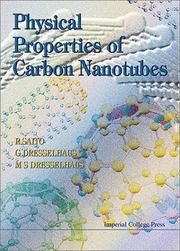
ISBN: 1281866237 9786611866235 1615832386 1860943799 9781860943799 9781860942235 1860942237 9781615832385 9781860940934 1860940935 9781281866233 661186623X Year: 1998 Publisher: London Imperial College Press
Abstract | Keywords | Export | Availability | Bookmark
 Loading...
Loading...Choose an application
- Reference Manager
- EndNote
- RefWorks (Direct export to RefWorks)
This is an introductory textbook for graduate students and researchers from various fields of science who wish to learn about carbon nanotubes. The field is still at an early stage, and progress continues at a rapid rate. This book focuses on the basic principles behind the physical properties and gives the background necessary to understand the recent developments. Some useful computational source codes which generate coordinates for carbon nanotubes are also included in the appendix.
Carbon. --- Nanostructured materials. --- Tubes. --- Group 14 elements --- Light elements --- Tubing --- Tubular goods --- Shells (Engineering) --- Nanomaterials --- Nanometer materials --- Nanophase materials --- Nanostructure controlled materials --- Nanostructure materials --- Ultra-fine microstructure materials --- Microstructure --- Nanotechnology
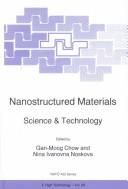
ISBN: 0792350715 9401061009 9401150028 Year: 1998 Volume: 50
Abstract | Keywords | Export | Availability | Bookmark
 Loading...
Loading...Choose an application
- Reference Manager
- EndNote
- RefWorks (Direct export to RefWorks)
A critical, up to date, tutorial review and discussion of the science and technology of nanostructured metallic and ceramic materials. The focus is on the synthesis and processing of nanoparticles, the assembly and stability of nanostructures, characterization and properties, and applications. There is a growing interest in the processing of nanoparticles into consolidated bulk materials and coatings. The metastability of nanoparticles may lead to undesirable grain growth during thermally assisted consolidation or other processing routes, and the retention of nanostructures in a processed part or component continues to attract a great deal of attention. Current activity is concentrating on the deposition of nanostructured coatings using established thermal spray technology and wet chemistry methods. Naturally existing or artificially synthesized templates with unique structures and morphologies have been used to fabricate nanostructured materials with the same structural and morphological characteristics as the templates. Recent advances in characterization techniques have provided information on the structure, the surface and bulk chemistry of nanoparticles, and the structures and chemistry of exposed and buried surfaces of coatings. Contributors are drawn from Canada, France, UK, USA, Belarus, Russia and Ukraine.
Alliages nanocristallins --- Materialen [Nanostructuur ] --- Materialen met een structuur op nanoschaal --- Matériaux de nanostructure --- Matériaux nanocristallins --- Matériaux nanostructurés --- Métaux nanocristallins --- Nanocristallins [Matériaux ] --- Nanomaterialen --- Nanomaterials --- Nanometer materials --- Nanophase materials --- Nanostructure [Matériaux de ] --- Nanostructure controlled materials --- Nanostructure materials --- Nanostructured materials --- Nanostructurés [Matériaux ] --- Nanostructuur materialen --- Ultra-fine microstructure materials --- Metals --- Ceramic materials --- Congresses. --- Materials science. --- Characterization and Evaluation of Materials. --- Material science --- Physical sciences --- Metals. --- Metallic elements --- Chemical elements --- Ores --- Metallurgy
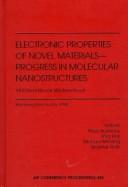
ISBN: 1563968088 Year: 1998 Volume: 442
Abstract | Keywords | Export | Availability | Bookmark
 Loading...
Loading...Choose an application
- Reference Manager
- EndNote
- RefWorks (Direct export to RefWorks)
67.014 <063> --- 67.017 <063> --- Carbon --- Fullerenes --- Molecular structure --- Nanostructured materials --- -Nanomaterials --- Nanometer materials --- Nanophase materials --- Nanostructure controlled materials --- Nanostructure materials --- Ultra-fine microstructure materials --- Microstructure --- Nanotechnology --- Structure, Molecular --- Chemical structure --- Structural bioinformatics --- Group 14 elements --- Light elements --- Chemical constitution and properties of materials--Congressen --- Physical and mechanical properties, workability and serviceability of materials--Congressen --- Electric properties --- -Chemical constitution and properties of materials--Congressen --- 67.017 <063> Physical and mechanical properties, workability and serviceability of materials--Congressen --- 67.014 <063> Chemical constitution and properties of materials--Congressen --- -Structure, Molecular --- Nanomaterials --- Tubes --- Tubing --- Tubular goods --- Shells (Engineering) --- Materials --- Congresses --- Molecular electronics
| Listing 1 - 6 of 6 |
Sort by
|

 Search
Search Feedback
Feedback About UniCat
About UniCat  Help
Help News
News